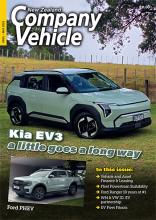Recent AfMA events featured a one-day conference followed by a second day focussed on diverse fleets (everything other than cars and LCVs) and a site visit, but this year the conference was a combined two days, with numerous breakout sessions interspersing the full session keynotes. The breaks were longer to give the attendees more time to visit the displays in the exhibitor area and to network with their peers.
Next year the venue will shift from the Melbourne Hyatt to the Convention Centre, which will give space to significantly expand the exhibition side of the event.
The theme for this year’s conference was driving change and looking at how transportation can play its part in the wider urban ecology.
The keynote speakers on day one were Peter Ellyard, a futurist, and John Mellor from GoAuto. John focussed on the practicality of electric cars in their current iterations, highlighting that petrol has 10 times the energy density of electricity (taking into account batteries). Vehicles such as chargeable hybrids and the Holden Volt with on-board generation overcome this.
He highlighted some interesting upcoming technology that will address these issues, such as an adjustable Australian-designed motor that can be depowered to increase range.
Even more interesting was new battery technology from MIT called “Cambridge Crude,” where the battery can be recharged by replacing the electrolyte in it with charged electrolyte, making recharging as quick as petrol refuelling.
However he said the internal combustion engine is fighting back, with smaller engines to lower friction (at cruise state engine friction is higher than the power consumed to propel the car) such as three-cylinder 1-litre engines with multiple turbos and high outputs, and reducing the load from accessories such as the fan, water pump, aircon, power steering etc. by electrifying them, plus seven and eight-speed gearboxes.
Day two’s keynote had presentations on Ancap safety standards and the roadmap for strengthening the testing regime to include active safety measures, BHP Billiton’s new fleet policy in terms of safety equipment, and upcoming developments in active safety focussed around predictive technology and driver comfort and information by Mark Jackman from Robert Bosch.
He said cars will soon be talking to each other so they can predict road conditions ahead (for instance a car slowing for an accident will warn cars behind), and with the use of camera technology there will be intersection assistance, lane and evasion assistance. The ultimate will be the ability for a road train of vehicles on motorways in an automatic linked convoy with a lead vehicle piloting them.
One theme that came through in a number of talks was the concerns in Australia around the Health and Safety issues of grey fleet vehicles. These are employee vehicles used for business purposes (particularly prevalent in the not-for-profit sector such as care giving etc), under the Health and Safety legislation in Australia (and New Zealand) - if a vehicle is being used for business purposes it is a workplace, and the employer is responsible for safety.
Concerns were expressed on how safety can it be managed when it is the employee’s vehicle –maintenance, licensing, etc. This is an issue that hasn’t really been discussed in New Zealand to date. There were a number of other interesting sessions which made the conference of great interest for New Zealand fleet managers wanting to increase their knowledge. Next year’s conference is on the April 1-2.



